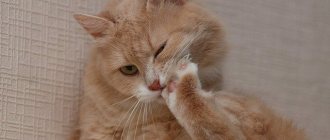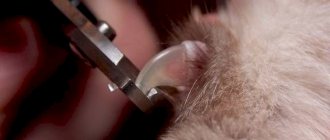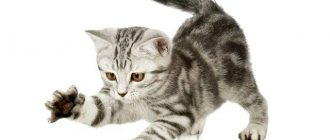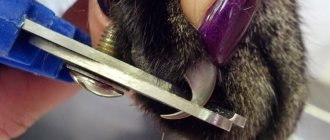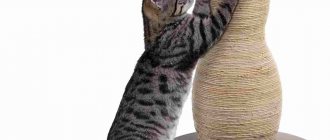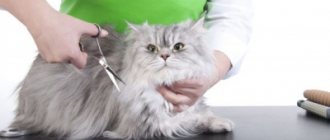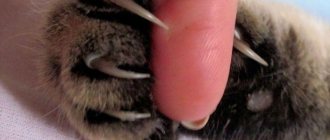Every pet owner will sooner or later face the problem of tattered furniture and wallpaper. The question will arise: can a cat’s claws be trimmed, and is such an ambiguous procedure dangerous for the pet? In the wild, animals wear down their claws naturally, climbing trees and running on hard surfaces. Pets often do not have such opportunities. So they have to sharpen their scratches on what they see in the apartment. And there is no escape from this; instinct is inherent in the animal by nature itself. It is possible to cope with such a problem, you just need to be well prepared.
Why do you need to trim your nails?
First of all, this is the cat's main weapon for protection and a hunting tool.
On the streets of the city, the animal has many enemies, from whom only teeth and sharp claws can help. Also, the cat’s natural arsenal allows him to win the lady of his heart or climb a tall tree in case of danger. Rodents are destined to become a hearty meal for lucky hunters with sharpened nails. However, pet owners ask the question: why trim a cat’s claws if it doesn’t go outside? And how to cut it correctly so as not to harm the animal? This treatment is needed, first of all, to prevent diseases and prevent abnormal growth of claws. Sharp, long claws can cause damage if they fall from a height. Another reason is to preserve the interior decor of the room (furniture, walls, interior items) and clothing. The process of scratching household utensils leads to scandals that negatively affect the mental state of both the cat and the residents of the apartment.
Leave a request for a cat hotel
There are good reasons when to apply a haircut:
- Keeping a cat at home. The animal is kept indoors only and does not go outside on its own. Because it is impossible to sharpen its claws in nature, it is forced to scratch furniture and walls, ignoring the scratching post.
- Having small children in the apartment. Sharp claws pose a danger to infants and preschoolers. In the game, an animal can injure a child and cause an infection.
- In case of illness or low mobility. An unhealthy cat cannot carry out hygiene activities on its own. Also, when a pet has an infantile temperament, is old or is overweight, then human help is needed.
- For preventive purposes, for aesthetics. Removing the upper part of the claws is important to prevent the occurrence of purulent foci of inflammation. The procedure is mandatory when the cat participates in exhibitions, for safe bathing.
It should be remembered that trimming nails causes deep stress in the animal. Therefore, the owner must analyze all the pros and cons. The need for the procedure must outweigh the risk of problems.
How to trim a kitten's claws
Kittens, like adult cats, need their nails trimmed. From 2-3 months of age, they begin to accustom the kitten to trimming its claws. When training to use a nail clipper, choose a moment when the kitten is well-fed and relaxed. The cutting area should be well lit.
- During the first lessons, do not immediately grab the nail clipper, just take the paw and press on the pads so that the baby gets used to such actions. If the kitten behaves well, praise and treat it. Most kittens need 2-4 lessons to calm down, but nervous pets may need to be trained to trim their nails for more than a week.
- When the pet sits calmly and does not pull out its paw, begin trimming its claws like an adult cat. For kittens, use only special small nail clippers. Cut carefully so as not to damage the living part and not to scare the baby with bleeding. In kittens it is clearly visible, but given the small size of the claw, care is required.
It is advisable to carry out the manipulation quickly, since a prolonged procedure may bore the kitten and cause resistance. For experienced people, trimming claws on all paws takes no more than 2 minutes.
Is it possible to trim a kitten's claws?
Kittens can and even need to have their nails trimmed. It is important to start accustoming your little kitten to trimming its claws from childhood. The optimal frequency for cutting is considered to be once every 30 - 40 days.
How often does it need to be trimmed?
It is impossible to answer this unequivocally. It all depends on the lifestyle and individual characteristics of the pet. The period between haircuts can be up to 2 weeks or once a month. Cats with black color should carry out the procedure very carefully. The minimum length should be removed, since the pulp is not marked at all. It is recommended to carry out treatment no more than once a week. Long-haired cats and sphinxes need to do this more often; they are susceptible to rapid growth and keratinization of their claws. People often ask: “The cat’s claws are crumbling and peeling—what should I do?” Of course, get a haircut!
Attention! A cat's claws need to be trimmed correctly. In the middle there is a pulp with a blood vessel, where the color is pink. If you touch this area, the cat will be in great pain and will bleed. If this happens, you need to quickly treat the wound site with any antiseptic, for example, hydrogen peroxide, and stop the bleeding.
What you need to prepare to trim your cat's claws
If a person knows why it is impossible to cut the nails of cats and kittens, but still decides to deal with this problem, then he should carefully prepare for it.
Before cutting your cat's nails, you should find the following materials and tools:
- Tweezers for cutting claws.
- Iodine.
- Cotton wool.
You can prepare a tonic that is used to disinfect the wound if it appears. It is also important to have a pharmaceutical product on hand that will quickly stop the bleeding.
How to prepare your cat for the procedure
It is advisable to choose a time when the pet is calm, well-fed, and in a good mood.
Before carrying out the procedure, it is necessary to prepare the cat: caress and massage its paws. Try not to worry or make any sudden movements. Animals immediately smell a catch and try to immediately run away. Each pet has its own character and this must be taken into account: adult cats are more nervous and suspicious, but it is much easier to negotiate with young kittens. First you need to sit comfortably, put the animal on your lap or on the table. It is advisable to ask someone else for help in order to fix it better. Perhaps the pet will begin to bite, scratch his hands, and try to escape. Just in case, the assistant needs to wear thick gloves or swaddle the cat in thick cloth. The procedure can be divided into stages, processing is carried out gradually. There is a nuance: before cutting, you need to remove excess hair between the pads on the paws. It is advisable to do without buzzing instruments so as not to frighten your pet. Then the idea will have to be left until next time.
Alternative to home nail trimming
We found out how to trim a cat's claws at home. But, unfortunately, not every owner can handle such an easy task if:
- The cat does not allow haircuts;
- The claws are black, so the pulp is not visible;
- After the procedure, the pet cannot recover for a long time, experiencing stress.
What to do if the owner with a nail clipper in his hands has failed, and the clawed pet is hiding under the bed? In some cases, you can do without a haircut. Let's consider methods of grinding and trimming nails that are alternative to home manipulations:
- Using a scratching post.
Sometimes owners try to help homebody cats by purchasing a scratching post. But not all pets like to use it, preferring the owner’s sofa as an object for sharpening. However, if you teach your cat to wear down its claws from a young age, then there shouldn’t be any problems. The simplest scratching post can be purchased at a price of 300 rubles; - Visit to the groomer.
In some cases, it is easier to pay a professional than to persuade an obstinate pet to remove its claws with scissors or a nail clipper. In the capital's salons, they ask for a service from 300-500 rubles, in Russia the prices are lower - from 150 rubles. The cost of trimming doubles if the cat is acting hostile. By the way, if the owner orders a range of services (bathing, haircut, combing), then in some salons the nails can be trimmed for free; - Buying anti-scratch caps.
Those owners who doubt whether they need to trim their cat’s claws should think about special silicone attachments. They are attached to the claw with glue (comes with anti-scratch pads) and last for at least a month. The following products are selected based on the size of the pet: XS – for animals weighing less than 2.5 kg; S – for miniature individuals weighing up to 4 kg; M – for medium cats weighing up to 6 kg; L – for healthy cats like Maine Coons. The cost of a package of anti-scratch pads (20 pieces plus a tube of glue) starts from 200 rubles. If the procedure for gluing the caps is done by a groomer, you will need to pay another 500-800 rubles; - Onychectomy.
The worst solution is to deprive the cat of its claws. However, such operations are carried out in veterinary clinics. If the owner is still interested in the question of how much it costs to declaw a cat, then the amount can reach up to 5,000 rubles. But such a surgical intervention has a lot of disadvantages:
- To remove the claw phalanx, anesthesia is administered (which is very unsafe for health);
- At home you will need to treat the seams on the paws (you can easily get infected);
- The cat will have to wear a special collar for a week (or more) to avoid damaging the stitches;
- After surgery, the animal may have problems coordinating movements;
- An “unarmed” cat experiences severe stress: it becomes withdrawn, apathetic, and sometimes aggressive;
- Finally, it is simply inhumane, as if the phalanges of all 20 fingers were amputated at the same time.
How to trim a cat's claws
To trim your cat's claws yourself, you should visit a pet store or veterinary pharmacy. There is a wide range of special tools available. These are ultra-modern devices and run on batteries or mains power.
Regular scissors.
Every home has a tool; it is allowed for trimming soft nails of young animals. The main condition is extreme caution so as not to cut off the excess part of the claw and not touch a blood vessel.
Claw clippers.
There is no need to experiment with ordinary nail clippers; here you need: a special pruner, reinforced nippers, nail clippers.
Guillotine trimmer.
A good device for removing the tips of thick, strong nails. Makes the cut as rounded as possible. The only drawback is the noise, which scares the cat.
Grinder.
The device is convenient and easy to use. The working element is a sharpening stone with an abrasive coating, which allows you to grind the surface painlessly. Polishing takes place gradually.
File.
It is better to purchase a tool with round ends; it will be needed to remove irregularities after working with nail clippers.
The devices must be well sharpened; it is recommended to give preference to stainless steel tools. The handles are made of non-slip material so as not to accidentally injure the animal.
Tools and materials
Today, pet stores and veterinary pharmacies are not uncommon; there are even in remote villages. There you can buy all the necessary equipment and accessories for caring for cats. Specialists will select any tool and answer questions regarding nail trimming.
For a cat manicure you will need:
- claw cutter - guillotine or pruning type pliers, with sharply sharpened blades. A blunt instrument can hit special areas and cause pain;
- nail cutter - scissors similar to a manicure device, but made to resemble a cat’s claw;
- grinder - a device in the form of a ballpoint pen with a small rotating rod that grinds down the hard tissue of the claw at high speed;
- sanding file;
- hair clipper. If the pet has long hair, then the hair between the toes must be cut off. For animals that cannot stand the sound of a working device, fur can be removed using ordinary scissors;
- antiseptic and hemostatic agent (for example, hydrogen peroxide, iodine). May be useful in case of accidental damage to the soft part of the claw;
- baby talc - for sprinkling wounds;
- alcohol-containing solution - for cleaning instruments. Items for claw trimming must be disinfected before the procedure.
Important! You cannot trim a cat's claws with regular scissors or a human manicure tool. You can only use a nail file.
Do all cats need to have their nails trimmed?
You should get a manicure if your cat is an indoor cat and does not go outside. When your pet walks in the fresh air or visits a dacha, you cannot cut its nails. A free-range animal wears down the tips of its claws while climbing trees or running on asphalt. Cats need them for defense against enemies; without them the animal is defenseless. Veterinarians do not encourage this procedure, especially if the pet is healthy. However, in some situations you need to do this:
- When an animal behaves aggressively, it is very dangerous for small children.
- Scratches walls, furniture, doors in the apartment.
- Clings to floor coverings and soft blankets, risking injury.
Under no circumstances should you trim the claws of a pregnant cat, as this can cause premature birth. If a small kitten has settled in the house, it is advisable to accustom it to the procedure from an early age. The baby hisses and bites - then you should postpone the lesson and repeat it later. The need for nail trimming may depend on the breed, for example, Sphynxes and Persians sometimes have specific problems.
In Persian cats, keratinized growths often grow and peel off. This occurs due to a deficiency of vitamins B and D in the body. Hair mats (mats) also form between the fingers, which need to be cut. The Scottish Fold breed often suffers from claw abnormalities, which needs to be carefully monitored and trimmed in a timely manner. If you don’t do this, your pet may get caught and pull out the claw completely. Also, during play, a cat can injure a person or other animal.
Nothing can replace the love of their owner for our pets. They trust us with their health and life. Let's make the stay of furry pets near us safe and calm. After all, our life becomes much more interesting with cats.
What to do if the animal resists
Pets, like people, have their own character; unfortunately, you don’t have to choose it. It is especially difficult when an animal comes into the home as an adult, with a mature character. Often cats taken from the street do not trust people. They use their formidable weapons, not allowing themselves to be taken into hand. It will be difficult for them to perform the procedures due to the risk of injury.
It is recommended that claw trimming for such rebels be carried out by two people: an assistant holds the cat, and the owner trims the claws. For safety, it is better to swaddle your pet in a towel or sheet. In extreme cases, you can purchase a special retainer bag. It will help to temporarily immobilize the animal in order to trim nails or perform other procedures.
Features of the structure of cat nails and rules for cutting them
After checking the tools, you can slowly begin processing. The first step is to properly “set up” the pet itself.
How to prepare a cat
You will have to “catch” the right moment: it is advisable that the cat be a little tired, sleepy, or at least calm when the haircut begins.
But you can’t interrupt his games and almost forcibly start cutting - the natural reaction will be rejection, and the animal simply won’t give in to your hands a second time.
Important! The most practical tools are those with rubber lining on the handles. Your hand may slip off steel surfaces. Wanting to avoid unnecessary injuries (both to themselves and to the cat), some owners swaddle their pets
This is also a good method that is used before trimming a cat’s claws at home.
Wanting to avoid unnecessary injuries (both to themselves and to the cat), some owners swaddle their pets. This is also a good method that is used before trimming a cat’s claws at home.
This procedure will be unclear to the cat at first, and you should not expect him to immediately raise his claws. You will have to stroke the paws, slowly moving onto the pads, which lightly press down (until the claw appears). This simple method is especially useful for small kittens: they get used to it and there are no special difficulties with them.
At the very start you will have to calm and caress the animal. It’s also useful to talk - this kind of “explanatory work” also helps. Be patient, especially if you are dealing with an older cat.
Did you know? Trained cats can replace sniffer dogs. One of these professionals was Rusik, who in 2001–2003. helped find fish from poachers smuggling their catch through a police picket in Stepnovo.
Pruning rules
Before trimming a cat's claws, take a disinfected tool with clean hands.
Then proceed like this:
The paw is held firmly, but gently. It should not twitch or slip out. Lightly press the center of the pad with two fingers so that the claw is fully exposed. Now a little anatomy. If you look closely in the light, you can see the free edge of the claw and the pink tissue inside it. This is a pulp with nerve endings and vessels, we do not touch it. The edge is removed so that at least 2 mm remains to the pulp. If the cat has dark claws, you have to act by touch, in 2-3 approaches, cutting off 1 mm each time. At the same time, scissors or a trimmer are held from above and perpendicular, trying to trim “in one fell swoop.” This is a matter of habit - after a few sessions it will be faster. At the end of the procedure, we adjust the edges to make it more comfortable for the cat to walk without clinging to its paws.
Due to inexperience, you can injure your paw. It’s unpleasant, but don’t panic—fill it with peroxide and calm the “patient.” The bleeding goes away quickly.
There seem to be no difficulties, but for the first time you will need the help of loved ones who will hold the cat.
Important! In some breeds, the pads become very overgrown and the hairs cover the claw. A clipper can help here (of course, if the animal is not afraid of it).. Don’t forget to trim all the claws, 5 on the front paws and 4 on the back
Beginners often forget about this “asymmetry” and, without looking closely, leave an old claw in front, which over time causes discomfort to the animal.
Don't forget to trim all the claws, 5 on the front legs and 4 on the back. Beginners often forget about this “asymmetry” and, without looking closely, leave an old claw in front, which over time causes discomfort to the animal.
Best articles: Baobab - description and photo of a giant long-lived tree
Reward for good behavior
During the operation, do not forget to praise your pet, even if he becomes restless.
To smooth out the first stress a little, give him a vitamin, or even better, a treat you have prepared in advance (what your pet adores). This will slightly accustom the cat to the idea that a haircut is not so scary.
Find out what to do if you find your pet has problems such as ringworm or ear mites.

